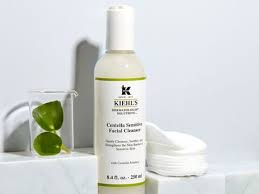Centella Asiatica in Skin Care Products
Centella asiatica, also known as Gotu Kola or Indian Pennywort, is a lesser known plant extract that offers notable skin care benefits. It is full of potent anti-aging compounds and helps develop collagen in the skin. Do you want radiant, youthful skin? With so many skincare products on the market, it can be overwhelming trying to find the right ingredients for your skin type. Keep reading to find my recommendations for the best products with centella asiatica in skin care! If you haven’t taken the Baumann Skin Type quiz to find the best regimen for you, you can click the button below to get started for free!
What is centella asiatica?
Centella asiatica is a perennial herb native to tropical wetlands in Asia and Africa (1). It looks kind of like a clover, but with one circular leaf. Also known as Gotu Kola or Indian Pennywort, this plant has been used for centuries in Ayurvedic and traditional Chinese medicine (2). Today, extracts from centella asiatica are gaining popularity in anti-aging skincare products. Here are a few of my favorites:
What is centella asiatica made of?
Centella asiatica contains active compounds called triterpenoids, including asiaticoside, madecassoside, asiatic acid, and madecassic acid (3). These phytochemicals are responsible for the herb’s healing and rejuvenating properties. Asiaticoside in particular has been shown to stimulate collagen production, a key protein in healthy, youthful skin (4). Besides these compounds, centella asiatica extract contains tons of saturated and unsaturated fatty acids that give it a rich, thick feeling on the skin.
Benefits of centella asiatica in skin care
Research shows that centella asiatica offers numerous benefits when applied topically:
Boosts collagen production (4)
Improves skin hydration and elasticity (5)
Reduces appearance of fine lines and wrinkles (5)
Speeds healing of wounds (3)
Fades scars and stretch marks (6)
Soothes skin inflammations like eczema (5)
Treats minor burns (3)
These varied effects make centella asiatica a useful ingredient for aging, damaged and sensitive skin. The triterpenoids stimulate new collagen while reducing redness and inflammation that can lead to skin aging.
is centella asiatica safe?
Is centella asiatica safe?
Numerous studies confirm that topical application of centella asiatica extract is very safe and non-irritating (7, 8). The EWG rates cantella asiatica as extremely safe and sustainable for use in skin care. Contact sensitivity is extremely unlikely even at high concentrations (8). Centella is non-toxic and considered gentle enough for daily use. The only potential risk is that it contains a high concentration of comedogenic palmitic fatty acids. This means that acne prone sensitive skin types might not react well to this ingredient.
Centella asiatica for anti-aging
Because it stimulates collagen production, centella asiatica is emerging as an exciting anti-aging ingredient. In one study, volunteers applying a cream with centella extract saw increased skin elasticity and firmer skin after just 4 weeks (5). After 8 weeks, they experienced less lines, smoother skin texture, and more even pigmentation.
Research also shows that the asiaticoside in centella asiatica protects skin cells from damage caused by UV radiation, pollution and other environmental stressors that accelerate aging (7, 3). By shielding your skin from harm and actively repairing damage, centella keeps your skin feeling youthful. Here are some of our favorite anti-aging products with centella asiatica:
Centella asiatica for wound healing
Centella asiatica has been used for centuries to heal wounds and burns in Ayurvedic and Chinese medicine (9). Modern research confirms its ability to accelerate healing. In one study, rats treated with centella healed wounds faster with less scarring compared to untreated rats (10).
For humans, centella creams also improve healing after surgery, burns, or scrapes. It stimulates new skin cell growth while reducing inflammation. This speeds up recovery time and prevents thick, raised scars from forming (7, 8).
Centella asiatica powder vs oil
You can find centella asiatica in skincare products in powder or oil form. The powder is simply dried, ground centella leaves. It retains the active compounds like asiaticoside. However, some experts believe making a tea or extract optimizes absorption.
Centella oil is an infusion of the leaves in a carrier oil, like olive or coconut oil. This allows the oil-soluble triterpenoids to be efficiently extracted into the oil. High quality centella oil delivers maximum benefits. Look for organic, cold-pressed oil for the best results.
Closing thoughts
Knowing your Baumann Skin Type is key to finding the perfect skincare routine. If you have aging, sensitive or damaged skin, centella asiatica may be right for you. Its collagen-boosting, healing properties make centella a top anti-aging and restorative ingredient. Try products containing centella asiatica powder or oil to achieve younger, healthier skin naturally.
DQH Knowledge drop: In your 20s, your skin cell turnover decreases. (Cell turnover is a key component in keeping your skin youthful.) You know what else slows down? Your collagen production. Starting in your 20s, collagen decreases by about 1 percent per year. Should you want to prevent fine lines and wrinkles, start by eliminating behaviors that contribute to premature aging. “If it’s bad for you, it’s bad for your skin,” says dermatologist Michel Somenek.
“Cigarette smoking reduces blood flow to the skin and causes premature wrinkling and a dull skin texture. Making the repeated pursed motion to inhale can also cause smoker’s lines. Alcohol and recreational drugs are toxins for the skin that damage its cellular structure and DNA,” Somenek tells us. “The faster you eliminate vices while you are young, the better chance your skin and body have to recuperate.” Also, adopting an anti-aging routine in your 20s is key. After all, the best offense is a good defense. We spoke to Somenek and experts Joshua Ross and Audrey Kunin to find out more.
Keep reading for the best anti-aging products for your 20s, according to skincare professionals.
Sunscreen
“We all know that the sun is the number one cause of skin aging and starting the prevention in your 20s is very important,” Ross says. “The majority of your sun damage won’t start to appear until you’re in your 30s, so don’t wait until you see it surface or you’ll be behind the curve. Stay ahead of it with a good-quality zinc-based sunscreen worn daily.”
Farmacy Green Defense Daily Mineral Sunscreen
An invisible sunscreen with SPF 30, plus botanical extracts meant to protect skin with tons of antioxidants. Bonus: It’s clean and fine to use under makeup.
Bareminerals Complexion Rescue™ Tinted Moisturizer Broad Spectrum SPF 30
Although we recommend you use your SPF and moisturizer separately, we also understand moments when you don’t have time or energy for that extra step. For those times, this bareMinerals moisturizer is a great thing to have on hand.
Vitamin C Serum
“A great introduction to anti-aging is to start with a vitamin C serum in your morning skincare routine,” Ross says. “It’s a powerful antioxidant that will neutralize free radicals and brighten the skin.” He adds that it’s a great way to counteract the effects of the sun’s harmful rays, which, as previously mentioned, are among the biggest causes of premature aging.
Drunk Elephant C-Firma™ Vitamin C Day Serum
The Drunk Elephant C-Firma is a lightweight serum that promises to give skin a glow by combining the brightening powers of vitamin C with ferulic acid, l-ascorbic acid, and vitamin E. The included sodium hyaluronate is meant to replace hydration loss, so you shouldn’t have to deal with any irritation.
Sunday Riley C.E.O. Rapid Flash Brightening Serum
This potent serum is jam-packed with vitamin C (15 percent, to be exact), which means it’s a potential superstar at both brightening skin and dousing it in antioxidants.
Peptides
Using peptides on your skin has many benefits, says Somenek. “The skin barrier is what defends the body against pollution, UV rays, bacteria, and toxins. It can be damaged by several everyday factors. Using topical peptides aids in building a stronger barrier,” he says. “Peptides comprise elastic fibers, which are a type of protein. These fibers help to make skin appear taut and firm. Peptides can also help repair damaged skin, relieve inflammation, and even out skin tone. Some peptides can kill acne-causing bacteria that is common in 20-somethings.”
Kunin agrees, saying, “Peptides are an excellent entry point for supporting collagen.” She recommends looking for face and eye treatments that contain these collagen-boosting powerhouses.
Charlotte Tilbury Magic Eye Rescue Cream
This Charlotte Tilbury super-emollient eye cream has a base of coconut oil and shea butter (read: it’s incredibly hydrating). Botanicals plus peptides are meant to help reduce dark circles and boost collagen, respectively.
This creamy moisturizer serves up potent collagen-boosting peptides and pycnogenol, and antioxidant-rich vitamin C. “Instead of sitting on top of the skin, peptides penetrate the outer layer so they go deep. The ‘signals’ they send tell the cells to produce elastin and collagen, which are needed for youthful-looking skin,” explains Somenek.
At-Home Peel Pads
Remember that skin cell turnover fiasco we talked about earlier? One way to help support it is by exfoliating. “Exfoliation is important to help keep skin fresh and luminous,” Kunin says. She recommends using at-home peel pads as an easy and effective way to exfoliate.
“The goal in your 20s is to fight the slowing pace of cell turnover. It is wise to use products that gently exfoliate, yet still remove oil and other impurities. Products that have Alpha Hydroxy Acids (AHA) or Beta Hydroxy Acids (BHA) are a good choice.”
According to Somenek, you should only exfoliate two to three times a week. “People of all ages are guilty of over-exfoliating and that can be too much of a good thing,” he says.
Dermadoctor Kakadu C Intensive Vitamin C Peel Pad
A few swipes of this Derma Doctor powerful peel pad promise to leave your skin glowing and smooth, thanks to the seven (yes, seven) types of chemical exfoliants, including AHA and BHA. It also contains vitamin C via Kakadu plum extract for added brightening and antioxidant protection.
KEY INGREDIENTS Kakadu plum extract is sourced from the Kakadu plum, a fruit grown in northern Australia. It contains vitamin C, which restores the skin’s natural barrier, increases collagen production, and soothes irritation.
Dr. Dennis Gross Skincare Alpha Beta® Universal Daily Peel Pads
These are the gold standard of peel pads, with a cult following and over 900 five-star reviews on Sephora. They’re easy to use and contain a blend of anti-aging exfoliating acids.
Emollient Night Cream
“In your 20s, you need to start upping the hydration in your skincare routine. You may have been cautious of over-moisturizing because of acne in your teens, but as you enter your 20s, your skin transitions and becomes drier,” Ross says. “I recommend an emollient night cream added into your evening skincare regimen.”
“Twenty-somethings need to make sure that they are not using creams that will clog their pores and cause excess oil production,” says Somenek. Opt for non-comedogenic products.
Cerave Skin Renewing Night Cream
One great choice is the CeraVe Skin Renewing Night Cream, which is a non-comedogenic night cream that leaves skin soft and glowy. It combines the moisturizing powers of ceramides and hyaluronic acid.
RoC Retinol Correxion Max Hydration Creme
“The best night cream ingredients contain retinol, benzoyl peroxide, and/or salicylic acid or hyaluronic acid. The goal is to moisturize, yet remove excess oil,” says Somenek. This Roc Retinol Correxion cream fits the bill as it contains both hyaluronic acid and retinol so it promises to moisturize while also being non-comedogenic.



